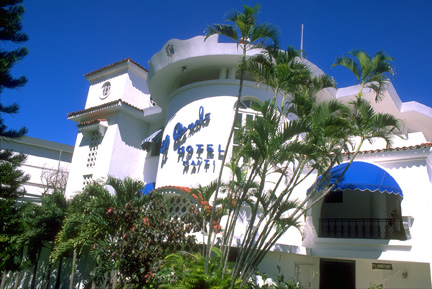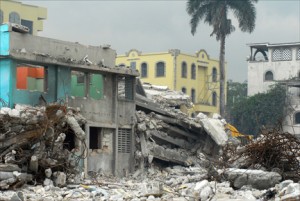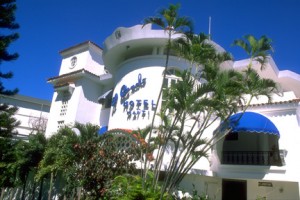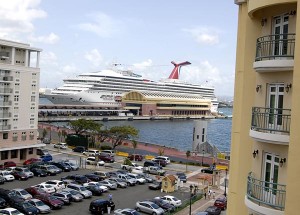Haiti’s ambitious tourism development plans could spark competition for P.R., other islands


Haiti is struggling to attract foreign investment and recover from the magnitude-7.0 earthquake that hit it more than two years ago. (Credit: Larry Luxner)
SANTO DOMINGO — New hotels, cruise ship projects and tourist facilities are all on the drawing board for Haiti as it struggles to attract foreign investment and recover from the magnitude-7.0 earthquake that leveled Port-au-Prince and destroyed the island nation’s fragile economy nearly two years ago.
Last month, officials established the Presidential Advisory Council for Economic Growth and Investment (PACEGI). The 32-member council is co-chaired by former U.S. President Bill Clinton, the United Nations special envoy to Haiti, and by Laurent Lamothe, a senior adviser to recently inaugurated Haitian President Michel Martelly.
“I wanted to become president of Haiti so I could help improve the lives of 10 million Haitians,” Martelly told more than 1,000 delegates from 18 countries attending the 12th Biarritz Forum, an annual gathering of influential politicians, economists and academics held this year in Santo Domingo.
“We no longer want to ask for money. What we want is investment that creates sustainable employment and becomes the engine of the Haitian economy,” said Martelly. “We want investors to make a profit because this way, Haitians will also gain. We have a natural beauty that we share with the Dominican Republic. We are working to change the image of Haiti and we’re going to present this beauty to the world.”
Haitian businessman Gregory Mevs, chief executive of the WIN Group, is special rapporteur to PACEGI’s Strategic Initiatives Committee.
“After the earthquake, it was obvious we needed to rebuild Haiti’s basic infrastructure and hospitality capacity,” said Mevs, interviewed on the sidelines of the Oct. 13-14 forum. “The urge to do sudden projects became almost a civic responsibility — projects like rebuilding the port, providing adequate logistics capacity, building additional hotel rooms for the city, creating industrial buildings and free zones, and starting housing projects.”
He added: “Like many other companies, the WIN Group is not alone in this responsibility. Many initiatives are on the way and at different phases of completion.”
Hotel projects in the pipeline
In addition to killing an estimated 225,000 people and leaving hundreds of thousands homeless, the January 2010 earthquake destroyed 1,000 of the capital city’s 1,600 hotel rooms — leaving only 600 rooms of all categories available for the thousands of aid workers suddenly flooding into the country.

Haiti’s El Rancho Hotel, located in the Port-au-Prince suburb of Petionville, was one of the country’s finest — but was badly damaged in the January 2010 earthquake. It is now being rebuilt. (Credit: Larry Luxner)
Among the new properties planned for Port-au-Prince is the 250-room Hotel des Artistes. Complete with conference facilities, the hotel’s design will feature a traditional Haitian arts-and-crafts motif, and will be located on a 21-acre property adjacent to Toussaint L’Ouverture International Airport. A private company will manage the hotel; groundbreaking is planned for December, with completion set for early 2013.
“We made a decision not to be a chain. It costs $1 million for a franchise, but if you have a good management company, you don’t need a name, especially for an airport hotel, said Mevs. He estimated total investment in the Hotel des Artistes at $38 million.
“This hotel will serve many Haitians returning to their country who will transit overnight on their way to the cities where they came from,” said Mevs, noting that 50 of its rooms will be for extended stays.
Marc Antoine Acra is general director of Industries Acra. His company is among several working to restore the Hotel El Rancho in Petionville. Before the earthquake, it had 150 rooms; the quake took out 50 of them. Acra said it will cost $6 million to $8 million to rebuild El Rancho, not including an additional 50 rooms that weren’t there to begin with.
In addition, a 130-room Best Western is being rebuilt in downtown Petionville; that project is worth around $20 million. Ironically, the original structure — Haiti’s first new international-brand hotel in a decade — had been inaugurated only a few days before the earthquake.
The 87-room Karibe Hotel & Convention Center, finished in February 2008, suffered considerable quake damage but has since been restored, while the world-famous Hotel Montana — which first opened in 1947 and was completely destroyed in the quake — may also be rebuilt.

The Puerto Rico government has anchored its campaign to lure back cruise ship business on new incentives and infrastructure. (Credit: © Mauricio Pascual)
Haiti draws cruise lines, competing against P.R., eastern Caribbean
Tourism investment in Haiti isn’t limited just to hotels.
“The government is looking at aggressive airport promotion efforts and offering concessions to build regional airports,” said Mevs, whose company is also involved in a planned $200 million expansion of Port-au-Prince’s commercial port. “Tourism is a factor of transportation. Everybody in the Caribbean has beautiful beaches, but Haiti has an added value: culture. Still, you must build access to these beaches and historical monuments. It’s all about logistics.”
With that in mind, Royal Caribbean Cruises Ltd. has already spent $50 million to expand its cruise ship port on the private island of Labadie off Haiti’s north coast. Last year, Labadie received 600,000 passengers; numbers are expected to increase for 2012.
Investments include the building of a road between Labadie and La Citadelle, a mountaintop fortress and palace built by Henri Christophe, the leader of a slave revolt that freed Haiti from French rule in 1804. La Citadelle and the adjacent Sans Souci palace are now a UNESCO World Heritage Site.
“Royal Caribbean is extending the range of their cruise-ship stop to the Citadelle. Roads are being built so the cruise passengers can spend more money,” said Mevs. “The next step is building hotels there, so people can stay overnight, or stay a few days and get the next ship back. This requires hotel infrastructure.”
As companies set their sights on Haiti, Puerto Rico’s tourism officials are scrambling to secure cruise ship business for the island that once was homeport to some of the most important cruise lines.
To that effect, last month local tourism organizations hosted this year’s Florida-Caribbean Cruise Association Convention and Tradeshow convention, with the hope of showcasing Puerto Rico’s advantages as a cruise ship destination, including one of the most developed port infrastructures of the Caribbean as well as an attractive incentives program.
Puerto Rico must re-insert itself into the cruise ship business, as the Dominican Republic is also looking to capitalize on its natural beauty to draw tourist traffic.
Grosse Caye eyed for mammoth cruise ship complex
Meanwhile, the Labadie port could soon dwarfed by a second, much bigger cruise-ship port being planned for Haiti’s southern coast.

Gregory Mevs, Marc Antoine Acra and former Costa Rican President José María Figueres, members of Haiti’s Presidential Advisory Committee on Economic Growth and Investment. (Credit: Larry Luxner)
San Aquino SA, a company formed by Haitian and Dominican investors, has won a 50-year concession from the Martelly government to develop a cruise ship complex on Grosse Caye — an uninhabited island located three miles off Haiti’s southern shore southwest of Jacmel.
The concession, whose dollar value has not been made public, authorizes San Aquino to make any type of tourism investment it wishes, such as cruise ports, hotels, airstrips, commercial centers, marinas and related side businesses. It also awards the investors a wide range of fiscal incentives and customs exemptions for imported goods necessary to build the project.
Principals involved in the San Aquino venture are Reginald Kawas, Didier Fils-aime, Federico Schad, Francisco Schad, Gregory Saba, John V. Handal and Steve Handal.
Construction is to proceed in four phases, with the first phase alone to include a 2,500-foot airstrip, a shuttle dock and boat departure dock, a central shopping street, a traditional village, an artifacts market, an amphitheater, a mountain bike path, a typical small fishing port and a marine aquarium
Thanks to its location, says a company fact sheet, “the island can be easily included in any of the cruise lines’ western or southern Caribbean routes. Its landscape varies from lush mountains to white-sand, deserted beaches. The diversity of the island and its surroundings offer great opportunities to develop a large number of land- and water-based shore excursions.”
The company — which couldn’t be reached for comment directly — announced recently that it seeks to attract developers interested in building hotel facilities on Grosse Caye.
“The island has some secluded beaches that provide the ideal private setting to develop boutique hotels, and mid-size to small hotels,” it said. “The San Aquino project includes an airstrip which will connect the island via regular shuttles to the main airport at Port-au-Prince.”












Oh yeah, the big deals with the big money now free to come in and take over the land for enterprise. The dollar signs are just dancing in their heads.